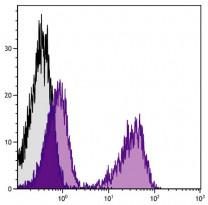ARG20999
anti-TCR beta antibody [H57-597] (PE-Cyanine 5)
anti-TCR beta antibody [H57-597] (PE-Cyanine 5) for Depletion,Flow cytometry,ICC/IF,Immunohistochemistry and Mouse
Overview
| Product Description | PE-Cyanine 5-conjugated Hamster Monoclonal antibody [H57-597] recognizes TCR beta |
|---|---|
| Tested Reactivity | Ms |
| Tested Application | Depletion, FACS, ICC/IF, IHC |
| Specificity | Mouse TCRβ. The clone H57-597 does not react with γδ TCR-bearing cells. Plate-bound or soluble H57-597 activates αβ TCR-bearing T cells. In vitro and in vivo, H57-597 can induce immature thymocytes to undergo apoptosis. In vivo administration of H57-597 has been shown to deplete αβ TCR-bearing cells to near completion and prevent graft rejection. |
| Host | Hamster |
| Clonality | Monoclonal |
| Clone | H57-597 |
| Isotype | IgG2 |
| Target Name | TCR beta |
| Antigen Species | Mouse |
| Immunogen | TCR affinity purified from mouse T-cell hybridoma DO-11.10 |
| Conjugation | PE-Cyanine 5 |
| Alternate Names | TCRB |
Application Instructions
| Application Suggestion |
|
||||||||||
|---|---|---|---|---|---|---|---|---|---|---|---|
| Application Note | * The dilutions indicate recommended starting dilutions and the optimal dilutions or concentrations should be determined by the scientist. |
Properties
| Form | Liquid |
|---|---|
| Buffer | PBS, 0.1% Sodium azide and Sucrose. |
| Preservative | 0.1% Sodium azide |
| Stabilizer | Sucrose |
| Concentration | 0.1 mg/ml |
| Storage Instruction | Aliquot and store in the dark at 2-8°C. Keep protected from prolonged exposure to light. Avoid repeated freeze/thaw cycles. Suggest spin the vial prior to opening. The antibody solution should be gently mixed before use. |
| Note | For laboratory research only, not for drug, diagnostic or other use. |
Bioinformation
| Gene Symbol | TRB |
|---|---|
| Gene Full Name | T cell receptor beta chain |
| Background | T cell receptors recognize foreign antigens which have been processed as small peptides and bound to major histocompatibility complex (MHC) molecules at the surface of antigen presenting cells (APC). Each T cell receptor is a dimer consisting of one alpha and one beta chain or one delta and one gamma chain. In a single cell, the T cell receptor loci are rearranged and expressed in the order delta, gamma, beta, and alpha. If both delta and gamma rearrangements produce functional chains, the cell expresses delta and gamma. If not, the cell proceeds to rearrange the beta and alpha loci. This region represents the germline organization of the T cell receptor beta locus. The beta locus includes V (variable), J (joining), diversity (D), and C (constant) segments. During T cell development, the beta chain is synthesized by a recombination event at the DNA level joining a D segment with a J segment; a V segment is then joined to the D-J gene. The C segment is later joined by splicing at the RNA level. Recombination of many different V segments with several J segments provides a wide range of antigen recognition. Additional diversity is attained by junctional diversity, resulting from the random additional of nucleotides by terminal deoxynucleotidyltransferase. Several V segments and one J segment of the beta locus are known to be incapable of encoding a protein and are considered pseudogenes. The beta locus also includes eight trypsinogen genes, three of which encode functional proteins and five of which are pseudogenes. Chromosomal abnormalities involving the T-cell receptor beta locus have been associated with T-cell lymphomas. [provided by RefSeq, Jul 2008] |
| Calculated MW | 35 kDa |
Images (1) Click the Picture to Zoom In






